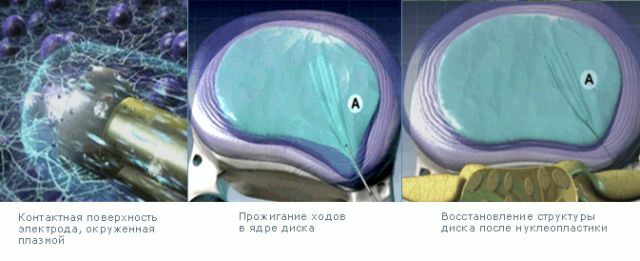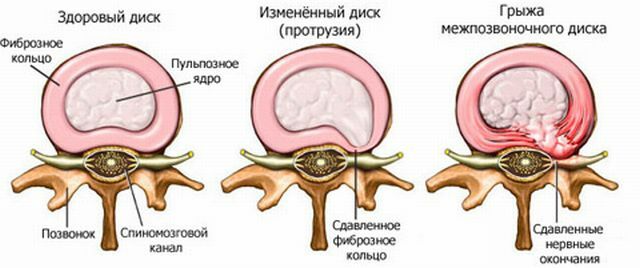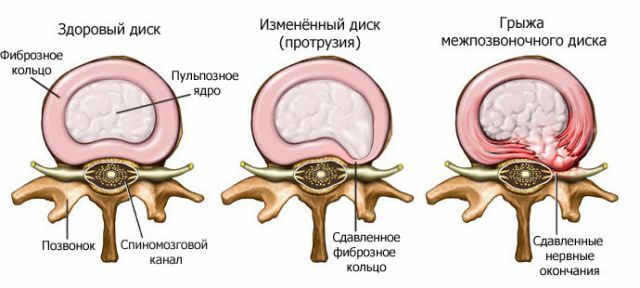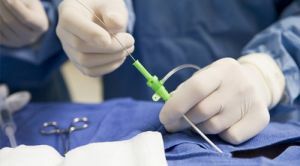 One of the most common diseases is the intervertebral hernia, which appears in patients 30 to 50 years old, injured or suffering from chronic diseases of the musculoskeletal system( osteoporosis, scoliosis, osteochondrosis and others).
One of the most common diseases is the intervertebral hernia, which appears in patients 30 to 50 years old, injured or suffering from chronic diseases of the musculoskeletal system( osteoporosis, scoliosis, osteochondrosis and others).
The emergence of a hernia is associated with a decrease in the amount of trace elements and water entering the intervertebral disc. If you do not interfere with the process, the drying of the site will begin, and in case of severe physical exertion, its destruction will begin.
In the medical language, the intervertebral hernia is a protrusion of the disc, which begins to press on the nerve endings and the spinal cord, causing pain in both the lumbar region and the lower limbs.
Conservative treatment of this disease consists in the removal of pain symptoms, while the cause of their occurrence is not affected in any way.
Contents of the article
- No alternative?
- Indications for operation
- The essence of the method
- The course of the operation
- What are the advantages?
- Possible complications
- Rehabilitation events
- Contraindications
No alternative?
It was the lack of an effective result and the return of neuralgic disorders that became a stimulus for cold-plasma nucleoplasty.
The analogue of nucleoplasty is laser vaporization, which is also often performed by surgeons. The essence of the method lies in the smooth heating of the disk by means of a laser, in which all the liquid contents of the nucleus begin to boil and evaporate.
Thus, the disk is compressed and compacted, thereby reducing the pressure on the nerve root.
However, for painless intervention it is necessary that there is a lot of liquid in the core, otherwise there is a risk of simply burning the tissues and harming the patient even more.
Therefore, this method has an age limit, which makes it less attractive than nucleoplasty.
Indications for operation
Cold plasma nucleoplasty for patients who have:
- Spinal disc protrusion up to 6 mm . The hernia compresses the spinal cord nerve root, pressing it to the
 of the vertebral bone. As a result, it loses its nourishment, there is swelling, non-microbial inflammation and suitable conditions for the cicatrical-adhesive process.
of the vertebral bone. As a result, it loses its nourishment, there is swelling, non-microbial inflammation and suitable conditions for the cicatrical-adhesive process. - Pain syndrome in the lumbar department of .Pain, which the patient experiences, has 3 sources: pressure, inflammation and swelling, which create a closed painful circle due to close connection with each other.
- The occurrence of pain in the lower extremities of the .Local spasm of the back muscles also causes muscle and spasm pain.
- No results in the conservative treatment of .Conservative therapy includes taking anesthetic medications that, at the time of treatment, reduce inflammation in the compressed root, and massage the back muscles. However, after stopping the course of drugs, painful pains in most cases return. In addition, manual therapy with complicated forms of osteochondrosis can lead to an increase in the rupture of the fibrous ring and the appearance of new ruptures in other discs.
The essence of the
method The cold plasma nucleoplasty( or cold plasma coblation) is a modern method, the incorporating the evaporation of a part of the intervertebral disc nucleus by means of a special electrode , whose contacts, having different electrical potentials, generate a cold plasma energy, which leads to a physiological decrease in the size of the tissuestructures.
Thus, decompression of the disc occurs, and the hernia ceases to exert pressure on the nerve endings and spinal cord.
Nucleoplasty is performed in a minimally invasive manner, which does not require a wide incision, which makes it applicable to other indications.
In addition, this procedure is suitable for patients suffering from concomitant severe illnesses( oncology, diabetes, heart disease and others).
Progress of operation
In the preparatory phase, the patient gives all the necessary tests and refrains from eating food and liquids 10 hours before the operation.
Also in the pre-operative period, an X-ray examination is performed, revealing the developmental anomalies, the position of the vertebrae relative to each other and the possible presence of dysplasias.
Manipulation is performed with combined analgesia, the patient is fixed in the "on the side" position and puncture needle is inserted into the intervertebral cavity, conducting the electrode with a cold plasma, the temperature of which does not exceed 45-55 degrees.
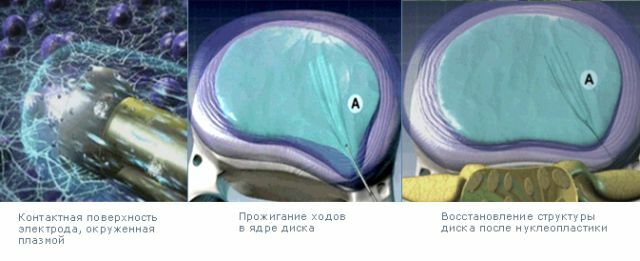
During the operation, several such injections are made, so that the pulpous core of the disk evaporates evenly. Throughout the intervention, the operated person is conscious, but anesthesia eliminates all uncomfortable sensations when injecting and injecting plasma.
The procedure takes from 15 to 30 minutes.
After the operation, the patient is transferred to a hospital where he is observed for 2-4 hours, after this time, he is allowed to get out of bed and walk. If the condition is satisfactory, the discharge takes place 5 hours after the procedure.
What are the pros?
Nucleoplasty has certain advantages over alternative treatment methods:
- surgical trauma is minimized, which excludes an emergency loss of blood;
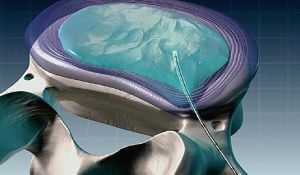
- absence of burning effect of tissues due to low plasma temperature, and, consequently, low morbidity of the procedure;
- low probability of damage to the nervous structure due to constant contact with the patient;
- , instability in the vertebral-motor segment is excluded;
- possible simultaneous intervention in multiple disks with multiple lesions;
- no scars and scarring.
Possible complications of
The main advantage of the procedure is the minimal possibility of complications. They are recorded in 0.1% of all operated patients.
Possible problems include:
- hematoma, developing in the field of intervention;
- reflex mediator pain;
- short-term radicular pain( if they disappear within two weeks after surgery, they are not a complication);
- is sympathetic, a burning pain that can occur after several days due to severe stress, increased physical activity or trauma.
Rehabilitation activities
Most of the complications can be avoided by implementing recommendations for rehabilitation, including:
- Taking non-steroidal anti-inflammatory drugs for 2 weeks.
- Refusal of active physical exercises .Not prohibited: walking, short trips by car and doing household chores.
- Restriction of physical procedures , aimed at the vertebral column.
- Wearing a fixing corset for potential activity.
Contraindications
This method has contraindications, which are not so many, but it is worth considering them for the successful conduct of nucleoplasty:
- exacerbation of neurological disorders, for example, the occurrence of sharp pain in the foot;
- worsening of the general condition of the patient;
- Failure integrity of the fibrous ring;
- loss of more than 50% of disk height;
- detection of a tumor or infection;
- narrow spinal canal;
- hernia, exceeding 1/3 the size of the spinal canal.
 At the moment, cold-plasma nucleoplasty occupies a leading position among methods struggling with intervertebral hernia.
At the moment, cold-plasma nucleoplasty occupies a leading position among methods struggling with intervertebral hernia.
It differs not only enviable efficiency and minimal probability of complications, but also absolute safety for humans, since it completely excludes thermal damage to the tissues of the disc.
For this service the price range in various clinics is very wide.
It all depends on the severity of the condition and the number of inflamed areas that you need to work on.

